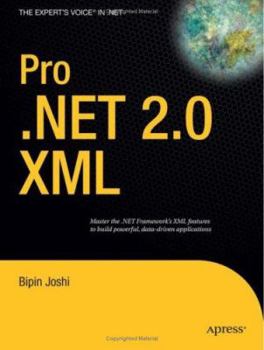Pro .Net 2.0 XML
XML is the de facto language for communication both within and between distributed applications whether they are on the Internet or a corporate network. It owes its success to its two key strengths: a highly-structured human readable format and the fact that it can be transmitted as pure text. No matter how disparate applications and their architectures may be almost everything can read text files and hence can accept XML data. This gives it a...
Format:Paperback
Language:English
ISBN:1590598253
ISBN13:9781590598252
Release Date:April 2007
Publisher:Apress
Length:499 Pages
Weight:1.83 lbs.
Dimensions:1.1" x 7.0" x 9.3"
Customer Reviews
4 ratings
Good Book, but obsolete
Published by Thriftbooks.com User , 15 years ago
This is the best dot net 2.0 XML book around. The content is clear and objective, covering every XML class that you can use in an application. But if you need to use XML, and framework 3.0 is not a problem, try looking for a LINQ for XML Book: faster, easier and much more simple! And remember: LINQ for XML is the best LINQ part ever! The other LINQ classes are not so amazing like those ones.
Excellent starter for .NET & XML
Published by Thriftbooks.com User , 16 years ago
I was looking for a book to get me started in XML. I wasn't interested in Web Services or anything like that, I just wanted to learn how to read through and do some clever things with XML. This book really helped me a lot. This should be the starting place for all .NET programmers wanted to begin XML. I appreciate the book it has helped me tremendously.
Great C# XML Guide
Published by Thriftbooks.com User , 17 years ago
This book is very well written with practical examples in C#. If you are an experienced developer you won't need much more. Enough said.
Solid book, broad but shallow
Published by Thriftbooks.com User , 17 years ago
This book has a number of flaws, but it's still a useful book for learning about using XML in the .NET world. There are a number of weakness in the book in that it's rather shallow and leaves out details or concerns on a number of topics. Examples include skimming over a DataSet's ability to infer a schema when reading data in. Are there any drawbacks? When would you use this? When might you want to avoid it? So with the negatives out of the way, let me focus on the positives, because they're definitely there. There's a lot of content on a broad range of topics. There's a very solid introduction to XML which is soundly and concisely written. The discussion of SAX and DOM is nicely done, and there are a large number of fundamentals which are well-written. You'll be able to learn the basics on things like XML's use of DTDs, how schemas roll into things, the basics of validation, and a number of other topics. The chapter on XML in ADO.NET has some good coverage on XML support in DataSets, and there are solid chapters on Web Services, SQL Server support, and a chapter which combines remoting, XML in ASP.NET, and configuration files. Joshi also wraps in a chapter on XML's role in WCF. I think the book's a solid introduction to XML in the .NET world.






